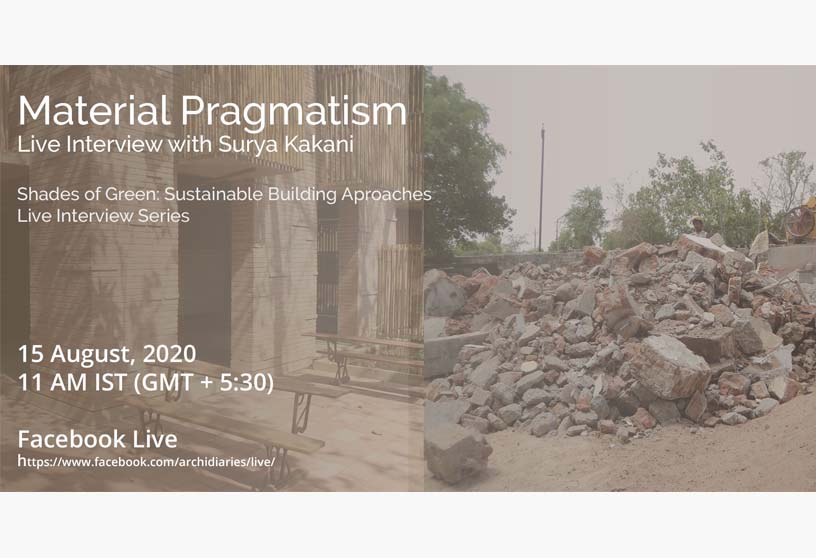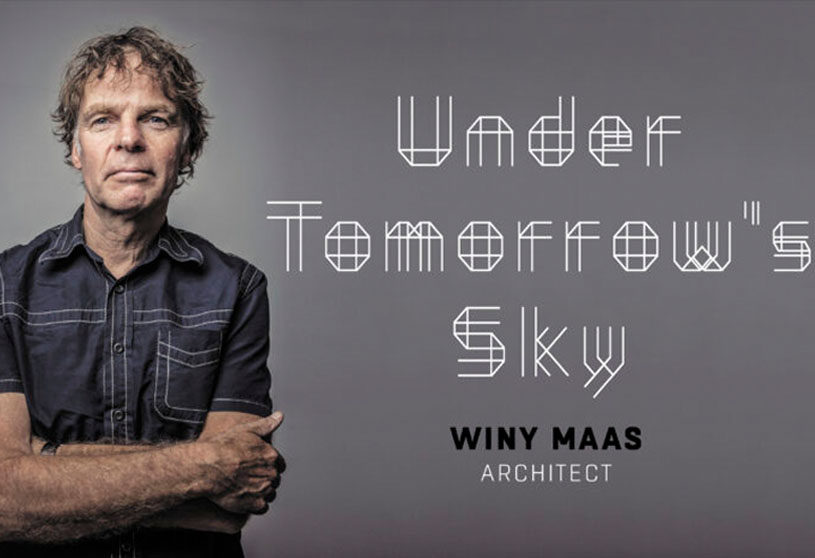Second in the series of Shades of green, our interview series where we talk to practicing architects about sustainability and its different approaches in architecture and design, is this presentation by Prof. Surya Kakani.
Prof. Surya Kakani’s practice at Kakani associates, Ahmedabad, explores architectural resolutions within a resource conscious framework. The practice mainstreams this concern through various building types of schools, hospitals and public institutions which has been published and acknowledged in various journals and conferences. It has also been his conscious endeavour to connect practice and academic pursuit both informing each other. He held the position of deanship at faculty of architecture, CEPT university, Ahmedabad, from 2017 to 2020.
Prof. Kakani starts with the viewpoint that everything that we do as architects revolves around the material, hence every time we swing between poetic and rational, we are actually in the material self. This discourse aims to discuss how imperative it is to consider the material reality in the age and time of today where there is a struggle to find the balance between resource consciousness and overconsumption.
“If material as a finite resource is our new god, staring ominously at us, how can architecture then, find new meanings?”

Prof. Kakani kickstarts his presentation by introducing us to his four key methods to look at material pragmatism: reusing a building, reducing carbon footprint, recycling materials, harnessing technologies of skill. Reusing the building: seeing the building itself as material, and finding ways to use it for another function. Reducing carbon footprint: materials that use lesser energy in its making. Recycling materials: ways where we think about methods to reuse the waste material from old buildings for new construction practices. Harnessing technologies of skill: In looking at social equity and construction methods that are used in our country, we can use it to relook at materials, thinking of ways to use skilled labour embedded in our culture at the urban scale.
Whether it is at the scale of industrial buildings or at redeveloping old buildings Prof. Kakani and his team have come up with a language that works towards constantly experimenting with material options, sustainable passive cooling techniques, and water harvesting systems.
From reusing buildings at residential and institutional scale to reducing the carbon footprint, Prof. Kakani’s use of recycled materials, distinct experimentation with passive cooling systems, and harnessing of skill show the extent of his unhindered spirit.
In implementing these methods we see his constant balance between doing and over-doing which is a rare delight in these material sensitive times. This balance brings forth his minimalistic and simple, language in architecture that we observe throughout his projects.



“That is the struggle, you are loath to use excess, you want to be frugal, yet create a space that you want to come back to. With all the environmental concerns you do not have to be disassociated with the ability to have joy in a space.”
In reusing buildings, old buildings and their surroundings are often left unattended or underused in the case of change in the needs of users. Prof. Kakani explains two such examples with a similar case. In Venture studio, we see his simple yet powerful efforts in space making. Residence 394 shows how it’s possible to live sustainably in an urban environment with the help of the right passive systems. In Madhu industries and Kakani associates studio, we see his fearless approach towards pushing to maximize the use of sustainable material options on every surface, in adverse times after the earthquake. We can observe the potential of using materials of lesser carbon footprint at an industrial and corporate scale. While being a mix of all the methods in some projects, we see the development of each method out of the four, specifically in every project.


“You may have all concerns, and say that you are using waste materials and reducing carbon footprint, but the challenge is how do you do all that and make all that you do evocative? How do you make your work have a certain quality that raises the experience of a place?”
Wadi school shows us the beauty of using a system of materials in a module and play of scales. The final flourish is the last project he shares, S.O.A.C.H an NGO in Ahmedabad, where Prof. Kakani talks about the latest maximum stretch that he and his team have gone with material pragmatism in practice with the making of timbrel vault and Rohtak domes of spans as large as 16mx5m.This project displays the technologies of skill, he so passionately talks about, which is present in the various types of skilled labor in our country. One such case is the team of masons that had worked on the rohtak domes, workers who come from rohtak and who have acquired the special skills to make these domes.The process of making these domes is so unbelivably poetic, he says that he spent a day with the masons in rohtak to experience them working with such beauty.
In the conversation with Ayaz, we see Prof. Kakani’s enthusiasm to share the knowledge he and his team has put into practice. This gives us a glimpse of his efforts as an academic where his practice informs the academics. His constant tussle to balance building and not overbuilding inspires us.


“With a little more patience, with a little push to achieve something and a little bit of a heart to fail..there are people who will do wonders for you”
In the dialogue, he also tells us humbly how he has been blessed to work with people like Himanshu Parikh, a structural engineer and Keyur Sarda, a founding member of Kesarjan, a Building Center that is committed to making the construction field environment friendly, to discover these systems and reappropriate them according to the urban conditions and scale of buildings at present. Kakani associates have also helped in the process of making these sustainable materials mainstream. For example, he talks about how lime was initially not accessible in an easy manner in the market and how kesarjan has made it possible now, after their initial projects that explored the material.

“The idea of an architect’s office, and how as a young architect you are so absorbed in the idea of the office and what it represents, and you want it to have the feeling of an architect’s office…and then you think back to whether it is really about us? What if tomorrow if it is no longer an office what about then, can it be used for some other function?”
The most interesting part of the conversation however is when Prof. Kakani talks about his journey from being a young architect and his ideas for an architectural office building to the present evolved self where there is a realization about the time difference between our life spans and the building materials. The discussion leaves us with the thought provoking questions and a zest to keep looking for the answer.
“Buildings have a life longer than us, they use resources and materials that have a life of their own, so the question is do we adapt to the building or does the building adapt to us? Who do we see ourselves to be? How much do we need to tailor-make the world around us, to be so specific to our every need, tolerance is important, at every level?We need to see what we are ready to tolerate in our environments? ”
The exchange of ideas is a captivating one, it illuminates us with knowledge about not only sustainable materials and methods to use them but the psyche and lifestyle that one can live with while pursuing to make the world’s environment a more healthier one.




